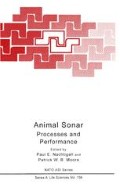Abstract
Norris and Møhl (1983) presented the hypothesis that odontocete cetaceans might be able to debilitate prey with intense sound and presented evidence to stimulate observation and experiment on this topic. This paper outlines our research on the hypothesis since its original proposal and extends the hypothesis by suggesting that dolphins can produce loud impulse sounds of low median frequency and long duration which might disorient prey. Sounds of 500 Hz to 5 kHz fall into the range of hearing or labyrinth sensitivity of prey species and the long duration (to 200 ms) could cause overloading of the unprotected fish ear.
Access this chapter
Tax calculation will be finalised at checkout
Purchases are for personal use only
Preview
Unable to display preview. Download preview PDF.
References
Au, W. W. L., Floyd, R. W., Penner, R. H., and Murchison, A. E., 1974, Measurement of echolocation signals of the Atlantic bottlenose dolphin, Tursiops truncatus Montagu, in open waters, J. Acoust. Soc. Am., 56 (4): 1280.
Ceruti, M. G., Moore, P. W. B., and Patterson, S. A., 1983, Peak sound pressure levels and spectral frequency distribution in echolocation pulses of the Atlantic bottlenose dolphin (Tursiops truncatus), J. Acoust. Soc. Am., 74 (51) A, S73.
Enger, P. S., 1967, Hearing in herring, J. Comp. Biochem. Physiol., 22: 527
Lilly, J. C., 1962, Vocal behavior of the bottlenose dolphin, Proc. Amer. Phil. Soc. 106 (6): 520.
Norris, K. S., Dormer, K. J., Pegg, J., and Liese, G. J., 1971, The mechanism of sound production and air recycling in porpoises: a preliminary report, in: “Proceedings of the Eighth Annual Conference on Biological Sonar and Diving Mammals,” Stanford Research Institute Press, Menlo Park, California.
Norris, K. S., and Mehl, B., 1983, Can odontocetes debilitate prey with sound?, Am. Nat., 122: 85.
Ridgway, S. H., Carder, D. A., Green, R. F., Gaunt, A. S., Gaunt, S. L. L., and Evans, W. E., 1980, Electromyographic and pressure events in the nasolaryngeal system of dolphins during sound production, in: “Animal Sonar Systems,” R. Busnel and J. Fish, eds., Plenum Press, New York.
Smolker, R. and Richards, A., This volume, Loud impulse sounds during feeding in wild Indian Ocean bottlenose dolphins.
Author information
Authors and Affiliations
Editor information
Editors and Affiliations
Rights and permissions
Copyright information
© 1988 Plenum Press, New York
About this chapter
Cite this chapter
Marten, K., Norris, K.S., Moore, P.W.B., Englund, K.A. (1988). Loud Impulse Sounds in Odontocete Predation and Social Behavior. In: Nachtigall, P.E., Moore, P.W.B. (eds) Animal Sonar. NATO ASI Science, vol 156. Springer, Boston, MA. https://doi.org/10.1007/978-1-4684-7493-0_57
Download citation
DOI: https://doi.org/10.1007/978-1-4684-7493-0_57
Publisher Name: Springer, Boston, MA
Print ISBN: 978-1-4684-7495-4
Online ISBN: 978-1-4684-7493-0
eBook Packages: Springer Book Archive

